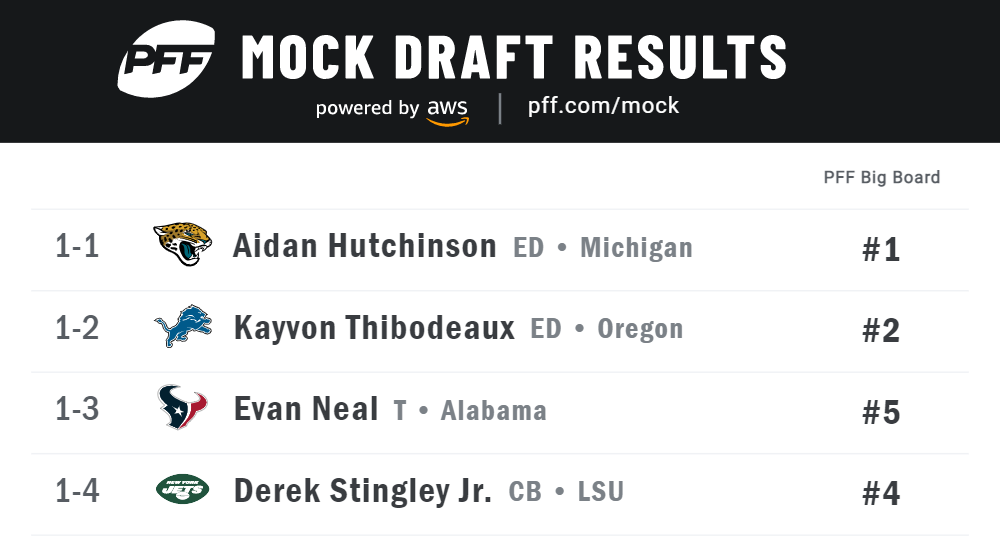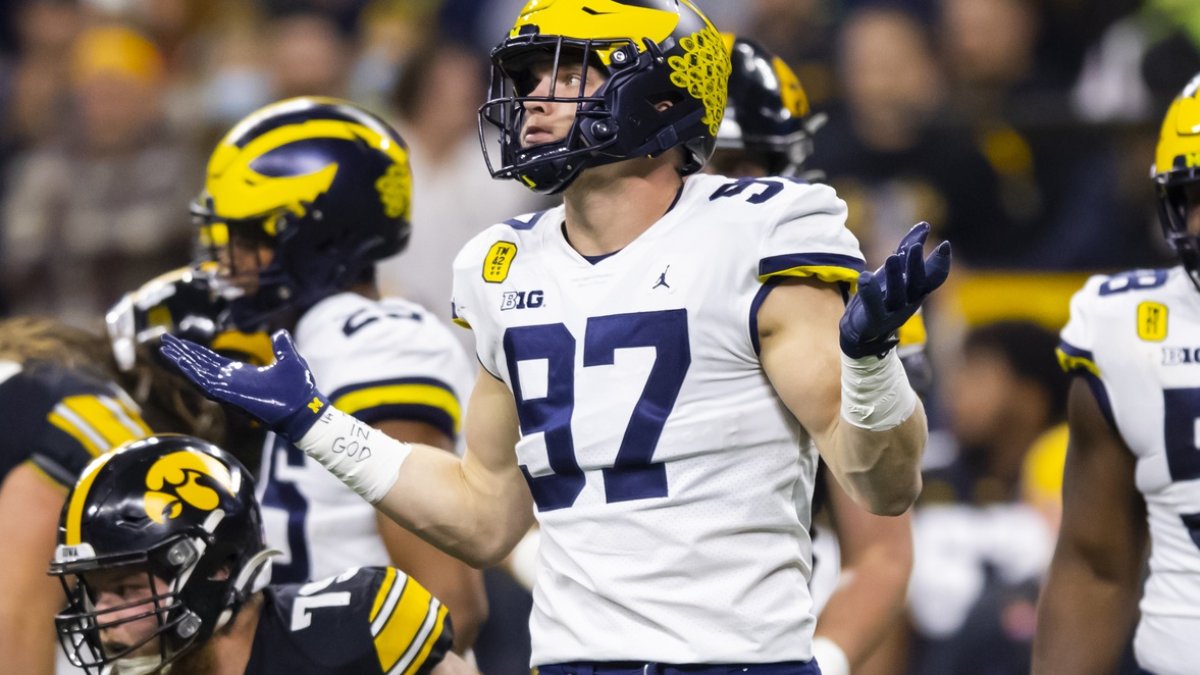NFL Draft prospects even at the same position come in with different shapes and have different skill sets, and thus would not evenly fit within every system in the NFL. As a result of this, this article will try and answer a simple question: Which team is the best fit for each prospect?
These decisions will be chiefly based off the clusterings found in our 2022 NFL Draft Clustering series and the individual stats used within that process. Additionally, for the sake of realism we will generally try and fit players with teams that have a realistic chance at obtaining these players without giant trades in the draft. At specific moments we will be spurning this rule for the sake of fun, but those moments will be rare.
Click here for more PFF tools:
Draft Guide & Big Board | Mock Draft Simulator
Dynasty Rankings & Projections | Free Agent Rankings | 2022 QB Annual
Player Grades
1. EDGE Aidan Hutchinson, Michigan: Houston Texans
Comparing Hutchinson and Kayvon Thibodeaux is impossible, so let’s dive right into it.
Their usage was nearly identical this past season, as both primarily lined up outside of the tackles in a two-point stance while spending some time between the tackles in subpackages.
Athletically, both players reportedly run 40-yard dashes in the high 4.6-second range and short shuttles within the 4.0-4.2s range, which puts both within the 90th percentile among defensive ends. Both are explosive, agile athletes whose main difference is that Hutchinson is supposed to have less bend than Thibodeaux.
Production-wise, their pass-rushing differences are minuscule. Hutchinson won 29.4% of his pass-rush reps while Thibodeaux won 26.6%, and on true pass sets (RPOs, play action, and screens removed), Hutchinson won 21.1% while Thibodeaux won 20.5%.
The main difference between the two is their run defense. In particular, Hutchinson won 23.7% of his reps against the run while Thibodeaux only won 13.7%. Thibodeaux still shows tremendous potential and is far from a weak link in that regard, as his 8.15% run stop rate and 3.86% run stuff rate both equal or exceed Hutchinson’s marks in the same statistics.
Thus, when determining each player's best fit in the 2022 NFL Draft, there shouldn't be a tremendous difference between the two as rookies. However, when accounting for the current difference in run-defense production, putting Hutchinson with the Texans makes slightly more sense because they have a weaker edge rusher rotation. Therefore, any edge-rusher they take will need to be more stout against the run.
2. S Kyle Hamilton, Notre Dame: Baltimore Ravens
We’ll start with the obvious, Hamilton will almost certainly not play for the Ravens in the 2022-23 NFL season, as the Ravens pick 14th and on 2022 College Big Data Bowl winner Jack Lichtenstein’s consensus big board, he ranks fourth while Benjamin Robinson’s Grinding the Mocks expected draft position (EDP) comfortably has him within the top 10. For the Ravens to realistically acquire him, they would need to trade up into the top 10, breaking a decade-long trend where their only first-round trade-up was to snag Lamar Jackson at pick No. 32 in 2018.
So why is Hamilton a fit with the Ravens? During his last season at Notre Dame, he spent 20% of his snaps in the box, 27% as a deep safety and 51% in the slot. Coupling this extreme versatility with his athletic numbers reported by Bruce Feldman in his annual “Freaks List,” there is plenty of reason to believe he can do anything a defense asks him. This doesn’t even mention his ludicrous production statistics, such as his run defense stuff rate, which ranked 39th among all 348 defensive backs that have been drafted since 2015. He is particularly interesting with the Ravens because he would be playing with one of the more creative defensive minds in football — Ravens defensive coordinator Mike Macdonald, who was more multiple with his single-high and two-high safety looks at Michigan. Macdonald would deploy Hamilton in a variety of roles and solve problems wherever they arise.
3. CB Derek Stingley, LSU: New York Giants
After his stellar freshman season, Stingley lost some luster in the eyes of some draft media due to injuries and slightly more inconsistent play. However, even in his injury-shortened final season, he was only targeted on 6.94% of his coverage snaps, which is 40th lowest of all FBS defensive backs that have been drafted since 2015. Stingley accomplished this despite playing a ton of man — LSU used Cover 1 (man coverage with a safety playing zone coverage in the deep middle) on 42.8% of its early-down plays, which was the second-most in the Power Five — and press coverage (46.8% of his snaps). This is elite production despite playing difficult scheme and PFF's own Diante Lee‘s film study backs up this assessment.
As a result, Stingley would likely find success in any man-coverage scheme; however, he would be particularly effective on the Giants with new defensive coordinator Wink Martindale.
4. EDGE Kayvon Thibodeaux, Oregon: Detroit Lions
As a prospect, Thibodeaux is generally scheme-proof since there aren’t many NFL defenses that struggle to incorporate an incredibly athletic and bendy edge defender. As described earlier, the only “hole” in Thibodeaux’s game is that he is not a high-level run defender, but he still shows clear room for growth in that department. Thus, Thibodeaux would likely find more early success in a situation where he were able to be on the field primarily during passing downs.
The Lions have a promising interior defensive line with Alim McNeill, Levi Onwuzurike, and Michael Brockers as well as a serviceable edge defender rotation with the Okwara brothers. This would allow Thibodeaux to come onto the field to rush the passer but give the Lions the flexibility to take him off the field if he struggles tremendously against the run early on.

Eug 101521 Oregonfb 14
5. OT Charles Cross, Mississippi State: Carolina Panthers
On true pass sets, Taylor Moton was the Panthers’ only offensive lineman who recorded more than 100 reps and a 60.0-plus pass-blocking grade. While with the Giants, new offensive coordinator Ben McAdoo leaned more heavily on gap runs than league average, calling them on 49.9% of their early-down rush attempts. Since Cross comes from an air-raid system that primarily ran zone concepts on their rare rush attempts, this may be an awkward fit initially. However, Cross posted a 94.8% pass-block win rate on true pass sets, which ranks 41st of the 117 FBS offensive tackles that have been drafted since 2015. The immediate boost he would provide to the Panthers’ pass protection would overshadow his potential awkwardness in the run game.
6. OT Ikem Ekwonu, NC State: New York Giants
Andrew Thomas has proven to be a strong pass protector, earning an 82.0 pass-blocking grade on true pass sets. However, the same cannot be said for the tackle opposite of him, as Matt Peart and Nate Solder earned mediocre at best 60.2 and 55.1 grades respectively.
Ekwonu initially does not necessarily solve this problem, as he is the weakest pass protector among the top-three offensive tackles with a 91.6% pass-block win rate on true pass sets, which ranks 101st out of 117 FBS offensive tackles that have been drafted since 2015. However, there is ample reason to believe that will develop in this area given that his production fell behind due to finer technique inefficiencies.
Additionally, he may seem to be a slightly awkward fit transitioning from a zone-heavy scheme at NC State to Daboll’s gap concept focus, as 57% of the Bills' early-down runs used gap concepts. Nonetheless, his notably nasty demeanor and athletic tools should more than make up for it alongside his 90.4% run-block win rate on gap runs, which ranks 60th among FBS offensive tackles and is on par with former Notre Dame Fighting Irish Ronnie Stanley.
7. OT Evan Neal, Alabama: Jacksonville Jaguars
One side of this equation is extremely simple. The Jaguars are likely to let OT Cam Robinson walk in free agency instead of paying his upcharged franchise tag. Although Walker Little looked strong in limited playing time and Jawaan Taylor had the best pass-blocking season of his career (72.1 pass-blocking grade), it would make sense to sure up their edges with some young talent.
Neal is the most balanced of this draft class' top-three offensive tackles. His pass-blocking metrics do not rank as highly as Cross’ and his run-blocking metrics do not rank as highly as Ekwonu’s; however, he does not struggle as much as either in their weaker category. Thus, for a team looking to rebuild and fill their offensive line with young talent, Neal is the sensible choice.
8. CB Trent McDuffie, Washington: Pittsburgh Steelers
This is another move that is not tremendously likely given the Steelers' interest in the quarterback market, as they have been linked to Liberty QB Malik Willis and San Francisco 49er Jimmy Garoppolo.
On the field, however, the scheme fit is natural given that the Steelers majored in Cover 3, using it on 45.3% of early downs. McDuffie comes from a defense that called Cover 3 on 41.4% of early downs — sixth highest in the Power Five.
While the finer details of the coverage almost certainly differ between the systems, McDuffie excelled in Washington's version. He was targeted at a fairly middling rate (11.1% of his coverage snaps), but his forced incompletion rate (13.5%) and coverage stop rate (3.13%) place him comfortably in the top third of all FBS defensive backs that have been drafted since 2015.
Additionally, his athletic profile positions him well to be Joe Haden‘s heir apparent in the long term and solidify their CB2 spot in the short term.

Exclusive content for premium subscribers

WANT TO KEEP READING?
Dominate Fantasy Football & Betting with AI-Powered Data & Tools Trusted By All 32 Teams
Already have a subscription? Log in




 © 2025 PFF - all rights reserved.
© 2025 PFF - all rights reserved.